A redefinição da senha do WordPress geralmente é um processo simples. No entanto, às vezes os métodos padrão não funcionam, fazendo com que você fique sem acesso ao seu site.
Alguns de nossos leitores se depararam com esse problema e pediram nossa orientação sobre a melhor maneira de acessar suas contas. Felizmente, você sempre pode usar a ferramenta phpMyAdmin no painel de controle da sua conta de hospedagem para redefinir sua senha diretamente do banco de dados do WordPress.
Neste artigo, mostraremos como redefinir facilmente uma senha do WordPress a partir do phpMyAdmin. Explicaremos cada etapa com clareza, garantindo que, mesmo que você não esteja familiarizado com bancos de dados, possa acompanhá-la com segurança.
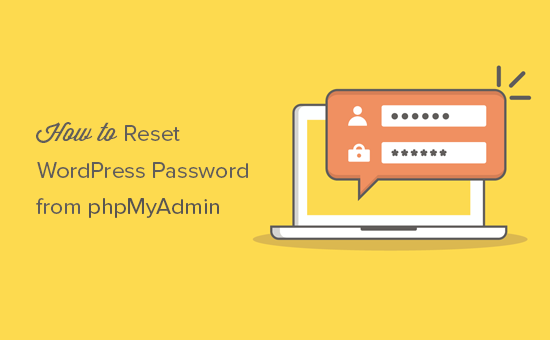
Por que redefinir uma senha do WordPress no phpMyAdmin?
O WordPress facilita muito a recuperação de uma senha perdida.
Basta acessar a tela de login do seu site WordPress e clicar no link “Esqueceu a senha?
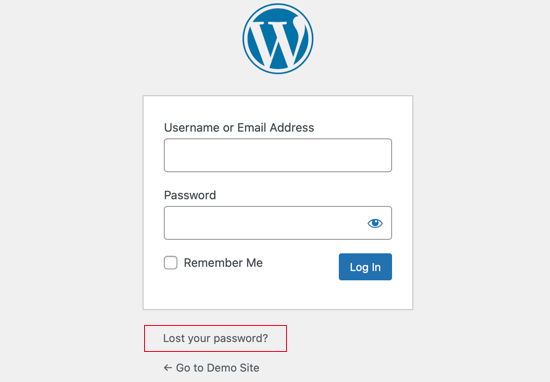
Ao clicar no link, você será levado à página de redefinição de senha. Depois de inserir seu nome de usuário ou endereço de e-mail, o WordPress enviará um link de redefinição de senha para o endereço de e-mail associado.
No entanto, se você não tiver acesso a esse endereço de e-mail ou se o seu site WordPress não enviar um e-mail, não será possível redefinir sua senha.
Nessa situação, você precisará redefinir a senha do WordPress diretamente no banco de dados. A maneira mais fácil de fazer isso é usar o phpMyAdmin.
Dito isso, vamos ver como você pode redefinir facilmente uma senha do WordPress no phpMyAdmin.
Como redefinir uma senha do WordPress no phpMyAdmin
Se não quiser assistir ao tutorial em vídeo, você pode continuar lendo a versão em texto abaixo.
Primeiro, você precisa fazer login no painel do cPanel da sua conta de hospedagem do WordPress. Em seguida, navegue até a seção Databases (Bancos de dados), onde poderá clicar no ícone phpMyAdmin.
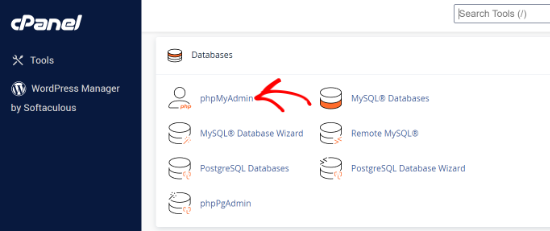
Isso iniciará o aplicativo phpMyAdmin.
Aqui, você precisa selecionar o banco de dados do WordPress no painel esquerdo.
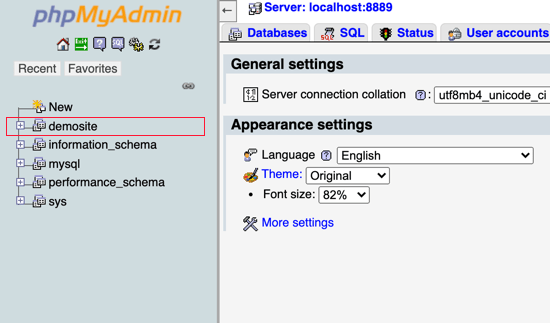
Agora você verá a lista de tabelas no banco de dados do WordPress.
Você precisa procurar a tabela wp_users nessa lista e clicar no link “Browse” (Procurar) ao lado dela.
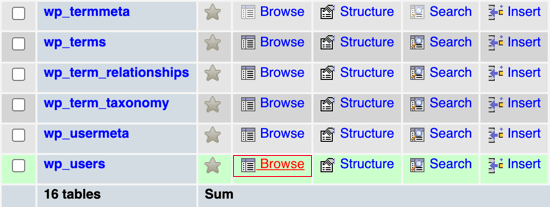
Observação: Os nomes das tabelas no seu banco de dados do WordPress podem ter um prefixo diferente daquele que estamos mostrando em nossa captura de tela. Alterar os prefixos das tabelas pode aumentar a segurança do seu site WordPress.
Agora você verá as linhas na tabela de usuários do WordPress. Vá em frente e clique no botão de edição ao lado do nome de usuário cuja senha você deseja alterar.
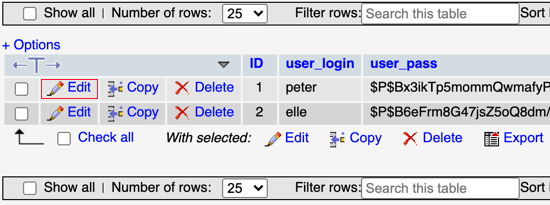
O PhpMyAdmin mostrará um formulário com todos os campos de informações do usuário.
Você precisará excluir o valor do campo user_pass e substituí-lo pela sua nova senha. Na coluna function (função), selecione MD5 no menu suspenso e clique no botão Go (Ir) na parte inferior do formulário.
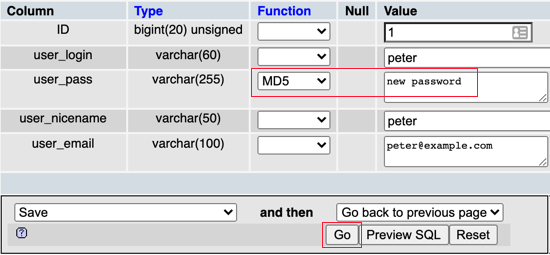
Sua senha será criptografada usando o hash MD5 e, em seguida, será armazenada no banco de dados.
Parabéns! Você alterou com êxito sua senha do WordPress usando o phpMyAdmin.
Alguns de vocês podem estar se perguntando por que selecionamos o hash MD5 para criptografar a senha. O WordPress usava anteriormente o hash MD5 para criptografar senhas, mas desde o WordPress 2.5 ele vem usando tecnologias de criptografia mais fortes.
No entanto, o WordPress ainda reconhece o MD5 para oferecer compatibilidade com versões anteriores. Assim que você fizer login usando uma cadeia de senhas armazenada como um hash MD5, o WordPress a alterará automaticamente para usar os algoritmos de criptografia mais recentes.
Guias especializados sobre senhas no WordPress
Agora que você sabe como redefinir uma senha do WordPress no phpMyAdmin, talvez queira ver outros artigos relacionados a senhas no WordPress.
- Como alterar sua senha no WordPress (guia para iniciantes)
- Como redefinir as senhas de todos os usuários no WordPress
- Como personalizar a página de redefinição de senha do WordPress
- Como forçar os usuários a alterar as senhas no WordPress – Expire Password
- Esqueceu a senha? Como recuperar uma senha perdida no WordPress
- Como forçar senhas fortes para usuários no WordPress
- Como adicionar a autenticação de dois fatores no WordPress (método gratuito)
- Como permitir que os usuários ocultem/mostrem senhas na tela de login do WordPress
- Como gerenciar senhas de forma fácil e segura (Guia para iniciantes)
Esperamos que este tutorial tenha ajudado você a aprender como redefinir uma senha do WordPress no phpMyAdmin. Talvez você também queira ver nosso guia passo a passo definitivo de segurança do WordPress para manter seu site seguro ou nossa seleção de especialistas de plug-ins obrigatórios.
Se você gostou deste artigo, inscreva-se em nosso canal do YouTube para receber tutoriais em vídeo sobre o WordPress. Você também pode nos encontrar no Twitter e no Facebook.





Graham
THANK YOU!!
I was caught up on the md5 encryption of the pw field. This really save my tail. I was using a member profile update which stripped all the email fields. This in turn also stripped mine and poof! Everyone’s password was deleted.
Seriously.
So, thank you a lot.
-Graham
Karen Seet
How do I find my “hosting provider” so I can get to phpmyadmin? I am new to this.
Muhammad Talha
Thanks a lot!
Edwin Calimlim
Great post, i wasn’t able to access my WP site for months already but thanks to this post, it is really a big help for me. Thank you.
atif shahab
Thanks alot. I was worried and stuck as well as i was unable to acess my WordPress dashboard for 2 hours. your recipe worked quickly. Thanks once again
WPBeginner Support
Glad it helped you solve the issue
Admin
Niculina
Thanks!! it worked! :):)
Joel
Lifesaver, thank you!
alan
What a fantastic email, new to C-panel but this tutorial was so clear I did it first time.
Great job.
Regards,
Alan
Trevor
Thank you !!!
Pedro
Did this now Jetpack gives me this error :
Jetpack could not contact WordPress.com: register_http_request_failed. This usually means something is incorrectly configured on your web host.
Operation timed out after 15000 milliseconds with 0 bytes received
Any tips on this?
Margie
Thank you so much. The instructions were easy enough for even me to follow
Carina
I wish it worked for me……I followed the directions [easy] but when I went to put in the MD5 hash numbers, they were exactly the same as what was already in the field value. This tells me that my problem is then not entering my user name and password that is the problem, but something completely different. …..:(
Thom Burlington
Thank you, but ..
while I can now reset the password with the MD5 code, derived from the new password I created, say, “abc” , and I finish and go back to my wordpress adimin signin:
domain.org/wp-admin : username ; password
for the password do I now use “abc” ?
Thom Burlington
Yes the password is “abc” – very nice – between your post and the video you are very clear, thank you.
Neal Kelshaw
Not quite correct. If you choose MD5 as the function in the drop down menu, and then type the password in plain text it hashes the value to an MD5 value.
tobi
awesome post thanks a lot
Jon O
Just wanted to say a BIG thank you for this article! I was indeed hacked and had sought assistance from my hosting company and others.. but this article was the only straight forward approach that worked first time! Thanks so much!
WPBeginner Support
Glad you found it helpful.
Admin
Tanya
I spent hours trying to find a website to explain why I was logged onto my WP then 5 minutes later I couldn’t log onto it again.
Thank you so much for the simple video. Problem solved in 5 minutes!
You rock!
WPBeginner Support
Glad you found it helpful.
Admin
Creina
Thank you. For anyone that finds the video confusing just follow the written instructions.
ashish
thank you so much for this tutorial…
Dairick
Thank you for this turorial
Parbat Devkota
thank you work charm.
Alexandra Jones
I’m the dunce from Mars who can’t speak computer. I’ll start with this:
“The best place to look is your wp-config.php file which is located in your root WordPress Directory.”
OK–where is it and how do I get there? I can’t log into my site because it will not any accept any password resets. I tried Chris’s phone method and got in on my phone, but not on my laptop. and when I tried to post something on the phone, I got a message that I should install the latest Jetpack, but I had to log into WordPress again, and guess what–“Invalid username.”
Is any of you who found these instructions such a breeze willing to speak to me on the phone? I’m writing from my wit’s end. That’s where I am. I would so appreciate it! Cheers!
WPBeginner Support
wp-config.php file resides on your web server. You can login to your web hosting control panel, locate the file manager, and then locate wp-config.php file. Alternately, you can also edit it using an FTP client.
Admin
Zania
Thank You! Thank You! Easy and worked like a charm!
chrismj06
You have saved my life. Bless u!
Jill
Thanks, you’re a lifesaver and this was easy to follow!
Kristen
You saved the day! Thank you!
AMIT KUMAR
Thank you ! I was simply trying to enter password. I never knew about the MD5 concept. Thanks again for a great tutorial.
Silviu
Thank you
Dubb
Awesome…you have saved the day once again my friend
Nigel
Awesome, thanks.
Skye
THANK YOU!!!!! Great article!
Kumar
Work like charm!!
hendriyana
Thanx !!! awesome.. helped for my problem….
Jaykesh
Amazing, thanks for quick help.
luis
Thanks a lot, I went into php admin and copy pasted the md5 password and i am in…..good job!
Muniyappa
Thank you very much..
Tony Garcia
A client’s developer passed away while on vacation of all things. You can only imagine what happened after that. Nobody knew anything of how their developer was doing things. Luckily I was able to locate where their databases were and got access to their PHPMyAdmin.
Voila!!! I have both of their lost sites back up and running with access to the back-ends because of this post.
Thank you!!!
Carol Long
Thank you! Life saver!
Lori
This saved me ENDLESS time. I’m not a tech novice but I am a novice at coding. These step by step instructions helped me regain access to my site! After losing access due to a “auto correct” error. (long story)
Thank you again!
christian gibson
You say that WordPress generates an MD5 encryption of your password? But I seem to remember seeing somewhere on Stackoverflow that this is no longer true. They said: “The WordPress password hasher implements the Portable PHP password hashing framework, which is used in Content Management Systems like WordPress and Drupal”.
I know very little about encryption/decryption systems, but one thing does seem strange. In a WordPress website database you can can see in the user table a field called ‘user-pass’ with contents like ‘$P$BlBAsz6jcvS3rLGDiE81PwtwbEazKg1’.
All the hash values in this table begin with $P$B….. so what on earth is the point of including these leading 4 characters if they are all the same……?
Samson
Thank you very much. saved me valuable time
Rod Salm
As always, straight forward, very helpful tutorials. Right to the point and bang on accurate. Like this phpadmin tip for passwords.
Thank you!
Ben Glancy
Or, if your admin account is the usual ID=1.
Open functions.php and put this code in
wp_set_password( “mypassword”, 1 );
Reload the page.
Uncomment code. Done.
Diana
Soooo helpful! Thank you!!!!
raaga
Thanks man. Very useful article.
Matthew Harris
Thanks for the tip, I couldn’t quite remember. Here is a return tip for you:
You don’t need the external MD5 tool. Look on the screenshot there is a “Function” column with drop down boxes. On the user_pass field just select MD5 in the function column and type your new password in normal plain text in the input box next to it. When you save it phpMyAdmin will automatically md5 hash it for you.
Amir
Great article. I found Matthew Harris’ tip simpler and tested it to work as well. Thanks!
Julian
Mr. Harris approach worked like a charm! Thank you.
Kevin B.
Very helpful. As a non-technical user, I felt powerless when an errant designer wouldn’t respond to my requests for passwords; this page with instructions filled the bill perfectly!
Many thanks,
KB
alex
Thanks!
Gustavo
Thanks for this great tip. I tried the “easiest” way above but couldn´t retrieve the automatic email because of some misterious server glitch.
I don´t know beans of PhP, so this kind of article is very useful for us.
Chris
I found the easiest and fastest work around the “Sorry, that key does not appear to be valid” issue to reset your WordPress password using your cell phone.
1.) Just use your cell phone to access your password reset email that was sent to you.
2.) Click on the link in the email. The link will automatically open the site where you can input your new password.
3.) Follow the prompts to enter your new password.
4.) Save your new password
5.) You should now be able to access your WordPress website with your new password from any computer, business as usual.
I hope this helps everybody!